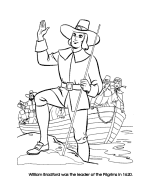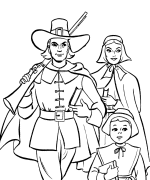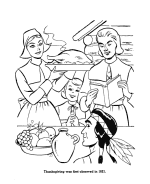




|
 |
 |
| |
The First Thanksgiving Coloring Page Sheets
The story of the first Thanksgiving between the Pilgrims and the Native Americans after the landing of the Mayflower in
Plymoyuth Colony, in coloring pages.
|
|
The story of the Pilgrims First Thanksgiving in America is the classic basis of the American Thanksgiving holiday lore.
Our First Thanksgiving coloring pages are a fun way to teach Pre-K through 3rd grade students about the Pilgrims and Thanksgiving in America and why
early Pilgrin settlers came to the new world.
|
| |
|



|

The First Thanksgiving Coloring Pages
Pilgrim leaders: William Bradford and Miles Standish
Pilgrims Landing
Pilgrim Life was difficult
Miles Standish coloring page
Pilgrims Trade for land coloring pages
Pilgrim Life coloring pages
Pilgrim Life coloring pages
Pilgrims wanted religous freedom
Pilgrims had freedom to worship in the "New World"
Squanto spoke english and helped the Pilgrims
Native Americans befriended the Pilgrims
Native Americans brought food
Native Americans at the First Thanksgiving
Pilgrims Thanksgiving Feast
Pilgrims prayed at the first Thanksgiving Feast
Horn of Plenty - Cornucopia - a symbol of Thanksgiving
|
| |
American Thanksgiving Coloring Page Sets
The Pilgrims Story told in Coloring Pages
>>> The First Thanksgiving Coloring Pages
Thanksgiving Holiday Coloring Pages
|
Plymouth Colony was founded by a group of people who later came to be known as the "Pilgrims". The core group (aprox. one half of the family
groupings) was part of a congregation of religious separatists led by pastor John Robinson, church elder William Brewster, and William Bradford.
While still in the town of Scrooby in Nottinghamshire, England, the congregation began to feel the pressures of religious persecution. In 1607 Tobias Matthew,
Archbishop of York raided homes and imprisoned several members of the congregation. The congregation then left England and emigrated to the Netherlands,
first to Amsterdam and then to Leiden, in 1609.
In Leiden, the congregation found the freedom to worship as it chose, but Dutch society was unfamiliar to these immigrants. Scrooby had been an agricultural
community, whereas Leiden was a thriving industrial center, and the pace of life was hard on the Separatists. Furthermore, though the community remained
close-knit, their children began adopting Dutch language and customs. The Separatists were also still not free from the persecutions of the English Crown;
in 1618, after William Brewster published comments highly critical of the King of England and the Anglican Church, English authorities came to Leiden to
arrest him. Though Brewster escaped arrest, the events spurred the congregation to move even farther from England.
In June 1619, after declining the opportunity to settle in New Netherland because of their desire to avoid the Dutch influence, the Congregation obtained a
land patent from the London Virginia Company, allowing them to settle at the mouth of the Hudson River. They then sought financing through the Merchant
Adventurers, a group of businessmen who principally viewed the colony as a means of making a profit. Upon arriving in America, the Pilgrims began working to
repay their debts.
Using the financing secured from the Merchant Adventurers, the Colonists bought provisions and obtained passage on two ships, the Mayflower and the Speedwell.
Though they had intended to leave early in 1620, difficulties in dealing with the Merchant Adventurers, including several changes in plans for the voyage and
in financing, resulted in a delay of several months. The Congregation and the other colonists finally boarded the Speedwell in July 1620 from the Dutch port
of Delfshaven.
The Mayflower arrived in Southampton, England, to rendezvous with the Speedwell and to pick up supplies and additional passengers.
Among the passengers to join the group in Southampton were several Pilgrims including William Brewster, who had been in hiding for the better
part of a year, and a group of passengers known to the Leiden congregation as "The Strangers". This group was largely made up of passengers
recruited by the Merchant Adventurers to provide governance for the colony and additional hands to work for the colony's ventures. Among the
Strangers were Myles Standish, who would be the colony's military leader, Christopher Martin, who had been designated by the Merchant Adventurers
to act as Governor for the duration of the trans-Atlantic trip, and Stephen Hopkins, a veteran of a failed colonial venture that may have been the
inspiration for Shakespeare's The Tempest.
"The Embarkation of the Pilgrims from Delfthaven in Holland" (1844) by Robert Walter WeirThe departure of the Mayflower and Speedwell for America was beset by
delays. Further disagreements with the Merchant Adventurers held up the departure in Southampton. A total of 120 passengers, 90 on the Mayflower and 30 on the
Speedwell, finally departed on August 15. Leaving Southampton, the Speedwell experienced significant leakage, which required the ships to immediately put
in at Dartmouth. After repairs were completed and a further delay ensued awaiting favorable winds, the two ships made it only two hundred miles beyond
Land's End before another major leak in the Speedwell forced the expedition to return again to England, this time to the port of Plymouth. The Speedwell
was determined to be unseaworthy; some passengers abandoned their attempt to emigrate, while others joined the Mayflower, crowding the already heavily
burdened ship. Later, it was speculated that the master of the Speedwell had intentionay sabotaged his ship to avoid having to make the treacherous
trans-Atlantic voyage.
The Mayflower, carrying 102 settlers, left Plymouth on September 6, 1620, without the Speedwell, and sailed for the New World with a land patent allowing
them to settle specifically at the mouth of the Hudson River. The voyage took almost two months as it was drawn out by strong westerly winds and by the Gulf
Stream. Turbulent seas and storms added to this delay. In one such episode, John Howland was thrown overboard, but managed to grab a topsail halyard that was
trailing in the water and was hauled back aboard safely. Land was sighted on November 9 off the coast of Cape Cod. The Mayflower made an attempt to sail south
to the designated landing site at the mouth of the Hudson but ran into trouble in the region of Pollack Rip, a shallow area of shoals between Cape Cod and
Nantucket Island. With winter approaching and provisions running dangerously low, the passengers decided to return north and abandon their original landing plans.
The location in Cape Cod Bay settled by the Plymouth Colony was outside the territory of the London Company, which had granted its patent. The northern coastal
territory had been granted to the Plymouth Company, but this patent fell into disuse after the failure of the Popham Colony. It was reorganized under a
sea-to-sea charter under the Plymouth Council for New England. The actual Plymouth Colony would obtain land patents from the Plymouth Council in 1621 and
in 1630, but it was governed independently from the Council under the Mayflower Compact.
*** Historic information courtesy of Wikipedia ***
|
|
|
|
 |
|


|

